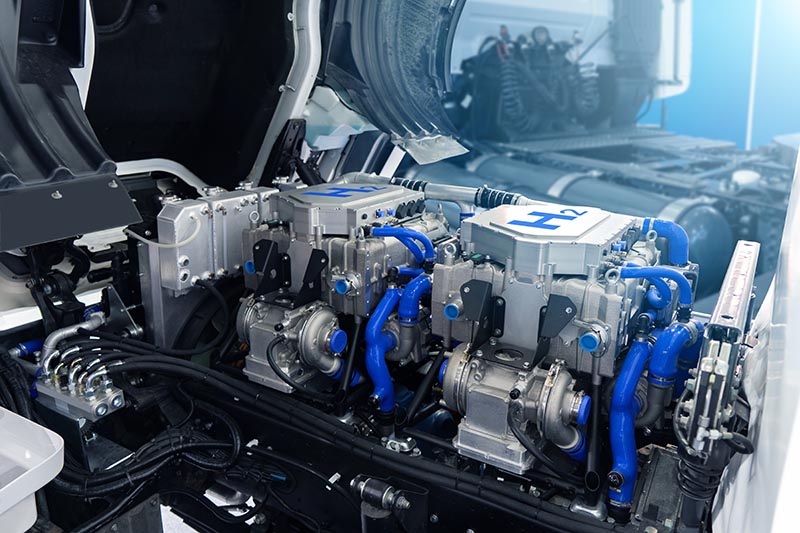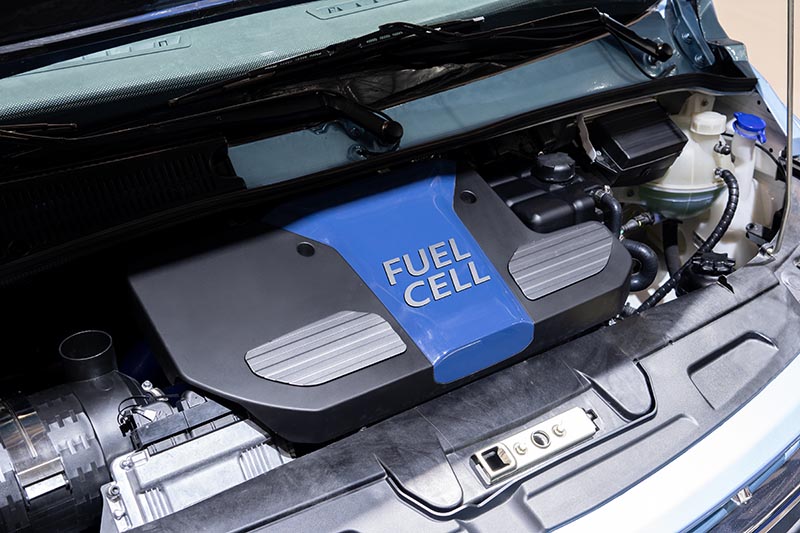How Do Hydrogen Engines Work? History, Origins, & FAQ
-

- Last updated:

When driving, we don’t think about how much power the gas engine has or how it performs. We just know that if we want to move from one place to another, it’s the best way to do it. After all, fossil fuels are the most used energy source by engines in transportation. But, have you ever heard of a hydrogen engine? Is it better than a conventional engine?
Hydrogen is not a fossil fuel—it’s made from water. Hydrogen engines are a clean, self-sustaining technology. They can also revolutionize modern society, and their only emission is water. This makes them cleaner than most traditional combustion engines. So, how do they work?
In this article, we’ll explain how a hydrogen engine works. We’ll also settle some arguments about whether it’s a viable alternative for powering vehicles. Do you want to learn more? Keep reading!
History of Hydrogen-Powered Engines
Hydrogen-powered engines have been around for a long time, but they’ve never been popular. There are many reasons for this, but the biggest reason is that it’s challenging to store and transport hydrogen. We’ll look at the problems hindering the development of hydrogen engines later in this article.
Let’s look at the history of hydrogen internal combustion engines.
First Hydrogen Internal Combustion Engine – 1806
Francois Isaac de Rivaz (a Swiss engineer) invented the first hydrogen internal combustion engine in 1806. It operated using a mix of oxygen and hydrogen. But this engine was never commercialized as it became a failure the following year.
Hippomobile Invention – 1860
Etienne Lenoir (a Belgian inventor) invented the three-wheeled Hippomobile. He electrolyzed water to create hydrogen. He used it to power a 1-cylinder, 2-stroke hydrogen internal combustion engine. Etienne sold between 350–400 Hippomobiles.

First Hydrogen Fuel Cell – 1889
Charles Langer and Ludwig Mond invented the first fuel cell in 1839. It used industrial coal gas and air.
First Hydrogen Internal Combustion Engine Vehicle Was Invented – 1930s
The first vehicle that used hydrogen as a fuel source was a hydrogen-powered truck. It used an ICE (Internal Combustion Engine) that used hydrogen extracted from an ammonia reformer. The Norsk Hydro Power Company in Norway developed it.
Shortage of Gas Fuels Progress of Hydrogen Engines – 1941
In 1941, a shortage of gasoline fuels prompted the development of hydrogen-powered engines. It was during the Second World War which took place from 1939 to 1945¹. During this war, Russia transformed 200 gas-powered trucks to operate on hydrogen. The trucks were used by Russia when fighting in the war.
Hydrogen-Powered Public Transportation Spreads Worldwide – 2018
The pioneers in using hydrogen fuel cells and hydrogen internal combustion engine vehicles are China and Norway. These countries started manufacturing fuel-cell buses and hydrogen engine vehicles in 2018.
But, hydrogen engines didn’t become popular due to various reasons we’ll discuss later on.
How Does a Hydrogen Engine Work?
The hydrogen engine is an internal combustion engine that uses hydrogen as its working fluid. The engine runs similarly to natural gas or diesel internal combustion engines. They also have similar engine components.
A hydrogen engine has a crank, connecting rods, engine block, and other components an ordinary engine has. The only difference is that it burns hydrogen rather than gasoline or diesel.
Hydrogen is extracted through a process called electrolysis¹. The procedure separates water into two primary components (Hydrogen and Oxygen). The hydrogen gas created by this process is stored in the fuel tank of the car’s engine.
When you start your car, the engine releases the hydrogen into a heat exchanger. Here, it’s used as a primary fuel source. The process is similar to other internal combustion engines but with some key differences. A simple explanation of the process is as follows:
Engine Processes Involved
- The piston moves up and down inside the cylinder, creating a vacuum behind it. It also creates a pressure difference. The pressure difference causes air to move into the intake manifold through an inlet valve.
- Then, the air passes through a carburetor or fuel injector. Here, it mixes with fuel from a tank and burns in the cylinder. The resulting combustion product expands rapidly. Then, it pushes through an exhaust valve at high speed, causing the piston to move down again.
- The cycle repeats itself again until no more hydrogen fuel is left in your tank. It also repeats until you turn off your car engine. To turn it off, engage the ignition switch.
Remember that a hydrogen engine works like an electric battery or generator. It uses a chemical reaction between hydrogen and oxygen to produce electricity. The chemical reaction in a hydrogen engine generates the same amount of energy as burning gasoline, but it doesn’t have combustion byproducts such as carbon monoxide and carbon dioxide (CO2). Instead, it produces only water, making this engine environmentally friendly.

Hydrogen Engine Horsepower and Torque
Like other engines, hydrogen engines are rated using two metrics: horsepower and torque. The power output of a hydrogen engine is measured in horsepower (hp) and torque (Nm). Horsepower is the power an engine produces over time¹.
Torque is a measurement of how much force an engine can apply at any given time. The two are related but not directly comparable. Hydrogen internal combustion engines can reach up to 290 hp or more. They can also have a torque of more than 100 Nm.
Hydrogen engines are an excellent alternative to gasoline or diesel internal combustion engines. Usually, the hydrogen engine’s horsepower and torque are lower than a comparable conventional engine. The reason is that hydrogen fuel contains less energy per unit volume than diesel or gasoline.
Usually, the horsepower and torque of a hydrogen engine depend on the size of its cylinders and the engine size. The main advantage of using hydrogen in internal combustion engines is its high energy density. It means a mass of fuel can be converted into a lot of power and energy.
Where Is a Hydrogen Engine Used?
Automobile makers prefer hydrogen internal combustion engines because of two reasons. One is their ability to run vehicles with zero emissions. The other reason is that hydrogen engines operate similarly to traditional 4-stroke engines.
The technology behind the hydrogen engine has been around for centuries, but it’s only recently that it has become viable to use in mainstream vehicles. These engines have several uses. They are used in cars, boats, and airplanes.
In space exploration¹, hydrogen engines are used to power spacecraft. They don’t have to carry large amounts of fuel. Besides, hydrogen has the least molecular weight.
Besides spacecraft, hydrogen engines are used in construction vehicles and equipment. These vehicles consume a lot of fuel during operation. Due to this, they emit a lot of carbon dioxide into the atmosphere. A hydrogen engine is a viable option as it doesn’t emit these harmful emissions into the atmosphere.
- Zero carbon emissions
- Hydrogen doesn’t produce odor
- Lower operating costs compared to ordinary gasoline engines
- Highly efficient
- Hydrogen is a renewable energy resource
- High thermal efficiency
- Hydrogen is expensive and getting it is challenging
- Backfiring is an issue with hydrogen internal combustion engines
- Power output and torque are less compared to traditional engines
- Producing a hydrogen engine is costly
- The auto-ignition of the hydrogen engine can lead to knocking. It can damage other engine components severely.

Challenges of Hydrogen Internal Combustion Engines
There are many reasons hydrogen engines are not popular in the transportation industry. Here are several challenges hydrogen engine adoption faces:
Under-Developed Infrastructure
The greatest challenge is the underdeveloped infrastructure for producing and distributing hydrogen fuel. Hydrogen is abundant, but it’s often found in compounds that are not separated from other elements easily.
It would be expensive to mine or extract such compounds to use them as fuel, and even more costly to transport them to where they’re needed. It’s essential to develop infrastructure for hydrogen extraction, distribution, and storage.
Lack of Regulatory Policies
The lack of regulatory policies for hydrogen-powered cars has been a primary obstacle to the adoption of this technology. It has made it difficult for manufacturers to invest in this technology. Moreover, no regulations govern how much hydrogen can be used to power internal combustion engines.
Automakers don’t have guidelines on manufacturing these hydrogen engine vehicles. It also makes it challenging for them to design better vehicles that meet consumer needs while being eco-friendly.
Lack of Integration
Hydrogen-powered ICEs (Internal Combustion Engines) are not currently integrated with the drivetrain. It means that they must be adapted to the existing engine design before they can be integrated into a vehicle. That’s why there’s no widespread use of hydrogen engines.
An added challenge is that it will take time for OEMs to adapt their manufacturing process to accommodate these new engines.

Frequently Asked Questions
Why Are Hydrogen Engines Not Commonly Used Today?
Hydrogen is a promising fuel for vehicles, but it doesn’t exist on its own. It must be extracted from water. If you’re wondering why hydrogen isn’t used in cars, it’s because of the infrastructure needed to produce and store the gas.
Hydrogen comes from water, but you can’t just take it from a tap or river. It needs electrolysis to extract hydrogen from water. The problem is that hydrogen is highly flammable. So, storing it needs special materials that won’t explode if exposed to heat or sparks.
What Is the Difference Between Hydrogen Engine Vehicles and Hydrogen Fuel Cell Vehicles?
Both hydrogen engine vehicles and hydrogen fuel cell vehicles run on hydrogen fuel. The primary difference is that hydrogen fuel cell vehicles use an electric motor to power the car. They generate electricity directly from a chemical reaction between hydrogen and oxygen.
On the flip side, hydrogen internal combustion engines burn hydrogen as part of their regular fuel with oxygen from the air to create energy. When the hydrogen is burned, it converts into mechanical energy. Hydrogen fuel cell vehicles convert hydrogen to electrical energy.
What Amount of Hydrogen Do You Need to Run an Engine?
The amount of hydrogen needed to run an engine depends on the type, size, and how much power it produces. A hydrogen engine uses 0.15 liters per minute for every liter of engine size. For instance, a 3-liter engine runs when producing 0.5 liters of hydrogen per minute.
Conclusion
One of the exciting things about the future of automobiles is that it’s constantly changing. In the coming years, we should see huge strides toward greener and more sustainable vehicles. Today, the automobile industry seems to have reached a dead end in its efforts to meet the stringent emission standards.
But one alternative promises to be a viable solution for all of these challenges: a hydrogen internal combustion engine. Hydrogen engines aren’t used in many vehicles out there. But you can be sure that they are considered a potential alternative to traditional engines.
There’s no getting around it—hydrogen is the future of energy. If you believe in a greener tomorrow, support new energy systems that use clean sources like hydrogen engines.
- US DEPARTMENT OF ENERGY
- NATIONAL ARMY MUSEUM
- NASA
- TOYOTA CANADA
- https://www.cummins.com/news/2022/01/26/how-do-hydrogen-engines-work
- https://www.fastechus.com/blog/the-surprising-history-of-hydrogen-vehicles
- https://www.cummins.com/news/2022/01/27/examples-hydrogen-engines-mobility-and-transportation
- https://www.carblogindia.com/hydrogen-combustion-engine-pros-cons/
- https://powertorque.com.au/cummins-unveil-a-hydrogen-combustion-engine/#:~:text=Cummins%20announced%20the%20testing%20of,the%20medium%2Dduty%20engine).
- https://www.techbriefs.com/component/content/article/tb/stories/blog/40818
- https://timesofindia.indiatimes.com/auto/cars/hydrogen-powered-cars-a-boon-but-crippled-with-challenges/articleshow/82405666.cms
- https://auto.howstuffworks.com/fuel-efficiency/alternative-fuels/fuel-cell-difference.htm#:~:text=While%20the%20combustion%20in%20a,is%20converted%20into%20electrical%20energy.
- https://www.hho-1.com/hydrogen-hho-facts/
Featured Image Credit: Scharfsinn, Shutterstock
Contents



